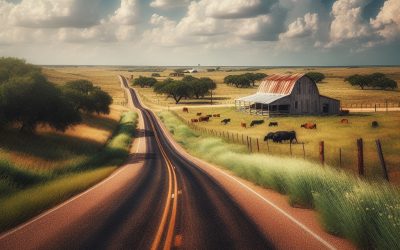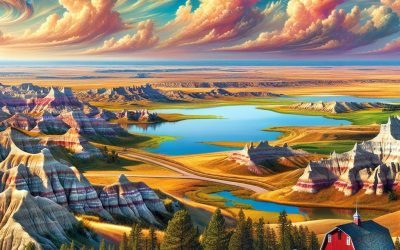Explore the World Through Geography, Natural Resources & Daily History
Clear, reliable and engaging guides that help you understand our planet — from UK geography education to global natural resources and On This Day history events.
Explore, discover, and learn about the wonders of our world! At Earth Site, we’re passionate about bringing geography, history, and science to life for curious minds of all ages. Whether you’re delving into historical events, uncovering the mysteries of the natural world, or seeking interactive resources, you’re in the right place.
Here, you can uncover the stories behind historical events, explore the natural wonders of our planet, and gain valuable insights into how the Earth’s systems shape our daily lives. From the towering peaks of mountain ranges to the far-reaching impacts of human innovation, we aim to make every topic both engaging and informative.
Start your journey of discovery with us today, and let’s make learning an adventure!
What We Cover
Earth Site brings together engaging and accessible educational content designed to help you understand the world, its history, and its natural systems.
🌍 Geography Education (UK & Worldwide)
We publish clear, easy-to-understand geography resources for students, teachers and curious learners. Our guides support geography education in the UK and cover physical geography, climate, ecosystems, population, and global development.
⛏️ Natural Resources & Environmental Geography
Explore detailed country profiles covering natural resources, mining, energy, geology and global environmental challenges. We show how nations manage minerals, water, land and ecosystems, and why these resources matter.
📅 On This Day in History
Every day has a story. Our On This Day history series features major events, anniversaries, traditions, and cultural milestones from around the world — with timelines, context, and fun facts.
TIMELINE
State of Texas
Texas, the second-largest state in the United States, is known for its rich history, diverse geography, vibrant culture, and strong sense of identity. With a population of over 29 million people, Texas has played a significant role in shaping American history and culture. From its Spanish colonization to its fight for independence and eventual statehood, Texas has a unique and fascinating story to tell. In this article, we will explore the history, geography, culture, famous Texans, sports, economy, tourist attractions, education system, politics, and the overall significance of Texas in American society. Summary Texas is the second largest state in the United States, known as the Lone Star State. Texas has a rich history, from Spanish colonization to becoming a state in 1845. The geography of Texas is diverse, with deserts, mountains, and coastline. Texan culture is known for its delicious food, lively music, and unique traditions. Famous Texans include Sam Houston, Willie Nelson, and Beyoncé. History of Texas: From Spanish Colonization to Statehood The history of Texas dates back to the early 16th century when Spanish explorers arrived in the region. They established missions and settlements to convert the indigenous population to Christianity and expand Spanish influence. However, in the early 19th century, Mexico gained independence from Spain and took control of Texas. This led to tensions between the Mexican government and American settlers who had migrated to Texas in search of land and opportunity. The fight for independence began in 1835 with the Battle of Gonzales and culminated in the famous Battle of San Jacinto in 1836, where Texan forces led by Sam Houston defeated the...
State of Tennessee
Tennessee, located in the southeastern United States, is a state known for its rich history, diverse culture, and stunning natural beauty. From the rolling hills of the Appalachian Mountains to the vibrant music scene in Nashville, Tennessee offers something for everyone. In this blog post, we will explore the history and geography of Tennessee, famous landmarks and attractions, the state’s role in the American Civil War, its economy and major industries, sports scene, education system, diverse population and cultural heritage, famous Tennesseans, and environmental issues and conservation efforts. Let’s dive in and discover all that Tennessee has to offer. Summary Tennessee is a state located in the southeastern region of the United States, known for its diverse geography and rich history. Some of the most famous landmarks and attractions in Tennessee include the Great Smoky Mountains National Park, Graceland, and the Country Music Hall of Fame. Tennessee has a vibrant music scene, with a history of producing influential artists in genres such as blues, country, and rock and roll. During the American Civil War, Tennessee played a significant role as a border state and saw many battles fought on its soil. Tennessee’s economy is driven by industries such as healthcare, manufacturing, and agriculture, with major employers including Nissan, FedEx, and HCA Healthcare. Overview of Tennessee’s history and geography Tennessee has a fascinating history that dates back thousands of years. Native American tribes such as the Cherokee, Chickasaw, and Creek inhabited the region long before European settlers arrived. In 1796, Tennessee became the 16th state to join the United States. The state played a significant role in the American...
State of South Dakota
South Dakota, located in the Midwestern region of the United States, is a state known for its vast landscapes of great plains and rolling hills. It is bordered by North Dakota to the north, Minnesota to the east, Nebraska to the south, and Wyoming and Montana to the west. With an area of approximately 77,116 square miles, South Dakota is the 17th largest state in the country. The state is often referred to as “The Mount Rushmore State” due to its iconic landmark, Mount Rushmore National Memorial. Summary South Dakota is a state with great plains and rolling hills. The history of South Dakota dates back to Native American tribes and eventually statehood. South Dakota has unique geographical features such as the Black Hills and Badlands. The climate in South Dakota ranges from harsh winters to mild summers. The economy of South Dakota is driven by agriculture, tourism, and manufacturing. The History of South Dakota: From Native American Tribes to Statehood South Dakota has a rich history that dates back thousands of years. The area was originally inhabited by various Native American tribes, including the Lakota Sioux, Dakota Sioux, and Nakota Sioux. These tribes lived off the land, hunting buffalo and practicing agriculture. European explorers first arrived in the area in the 18th century. French fur trappers were among the first Europeans to explore South Dakota, followed by American explorers and settlers. In the early 19th century, conflicts between Native American tribes and settlers began to arise as more and more settlers moved into the area. South Dakota became a territory in 1861 and achieved statehood on November...
State of South Carolina
South Carolina, located in the southeastern United States, has a rich history and diverse geography. The state was first settled by Europeans in the 16th century and played a significant role in the American Revolution. South Carolina was also one of the first states to secede from the Union during the Civil War. Today, it is known for its beautiful coastline, historic cities, and vibrant culture. Geographically, South Carolina is divided into three distinct regions: the Upstate, the Midlands, and the Lowcountry. The Upstate is characterized by its rolling hills and mountains, including the famous Blue Ridge Mountains. The Midlands region is a mix of forests and farmland, while the Lowcountry is known for its marshes, rivers, and barrier islands. The climate in South Carolina is generally mild, with hot summers and mild winters. The state experiences a significant amount of rainfall throughout the year, particularly during the summer months. This climate is ideal for agriculture and contributes to the state’s diverse natural beauty. Summary South Carolina has a rich history and diverse geography, from the Blue Ridge Mountains to the Atlantic Coastline. The state is home to natural wonders, cultural heritage, and a famous food scene, including Lowcountry cuisine and barbecue. Visitors can explore historic Charleston, Myrtle Beach, and Hilton Head Island, and enjoy sports and recreation like golf, fishing, and hunting. South Carolina’s economy is driven by agriculture, manufacturing, and tourism, and the state offers education from kindergarten to higher learning institutions. Living in South Carolina offers a relatively low cost of living, affordable housing, and a high quality of life. Discovering South Carolina’s Natural Wonders:...
Rhode Island
Rhode Island, located in the New England region of the United States, is the smallest state in the country. Despite its small size, Rhode Island is packed with history, natural beauty, and a vibrant culture. It is bordered by Connecticut to the west, Massachusetts to the north and east, and the Atlantic Ocean to the south. With a total area of just 1,214 square miles, Rhode Island may be small, but it offers a wealth of attractions and activities for visitors. Fun facts about Rhode Island include its nickname as the “Ocean State” due to its extensive coastline and maritime history. It is also known for being home to the Tennis Hall of Fame and the oldest operating carousel in the United States. Rhode Island was one of the original 13 colonies and played a significant role in the American Revolution. Today, it is known for its beautiful beaches, charming coastal towns, and thriving arts scene. Summary Rhode Island is the smallest state in the USA, but it has a rich history and diverse culture. From colonial times to modern day, Rhode Island has played an important role in American history. Rhode Island’s natural beauty includes beaches, parks, and wildlife, making it a great destination for outdoor enthusiasts. The state’s art and culture scene is also thriving, with museums, galleries, and festivals showcasing local talent. Rhode Island is famous for its seafood cuisine, but it also offers great shopping destinations, sports and recreation opportunities, and top-notch universities. Rhode Island’s Rich History: From Colonial Times to Modern Day Rhode Island has a rich history that dates back to colonial times....
Pennsylvania
Pennsylvania, also known as the Keystone State, is a state located in the northeastern and Mid-Atlantic regions of the United States. It is bordered by Delaware to the southeast, Maryland to the south, West Virginia to the southwest, Ohio to the west, Lake Erie and the Canadian province of Ontario to the northwest, New York to the north, and New Jersey to the east. Pennsylvania is known for its rich history, diverse geography, and vibrant culture. The nickname “Keystone State” comes from Pennsylvania’s central location among the original Thirteen Colonies. Just as a keystone is the central stone that holds an arch together, Pennsylvania was seen as a key state in holding the newly formed United States together. The state played a crucial role in the American Revolution and has been an important center of industry and commerce throughout its history. Summary Pennsylvania is known as the Keystone State due to its central location and role in early American history. William Penn founded Pennsylvania as a haven for religious freedom and tolerance in the late 17th century. Pennsylvania’s geography is characterized by its mountain ranges, rivers, and fertile valleys. The state experiences all four seasons, with hot summers and cold winters. Pennsylvania’s economy is diverse, with a strong presence in agriculture, manufacturing, and services. History of Pennsylvania: From William Penn to the American Revolution Pennsylvania has a rich colonial history that dates back to the early 17th century. The area was originally inhabited by Native American tribes such as the Lenape and Susquehannock. In 1681, King Charles II of England granted a charter to William Penn, a Quaker, to...
Oregon
Oregon, located in the Pacific Northwest region of the United States, is a state known for its stunning natural landscapes, vibrant cities, and commitment to sustainable living. Bordered by Washington to the north, California to the south, Idaho to the east, and the Pacific Ocean to the west, Oregon offers a diverse range of geographical features, including mountains, forests, and coastlines. With its mild climate and abundant rainfall, Oregon is often referred to as “The Pacific Wonderland.” Summary Oregon offers a diverse range of natural wonders, from mountains and forests to coastlines and lakes. The state has a rich history, with a focus on Native American culture and modern-day innovations. Oregon’s food and drink scene is thriving, with a farm-to-table ethos and a craft beer culture. The state is home to a vibrant art and culture scene, with museums, galleries, and festivals to explore. Outdoor adventure is a must in Oregon, with hiking, biking, rafting, and more available throughout the state. Exploring Oregon’s Natural Wonders: Mountains, Forests, and Coastlines One of the main attractions of Oregon is its diverse natural landscapes. From towering mountains to lush forests and picturesque coastlines, there is something for everyone to enjoy. One of the most famous natural wonders in Oregon is Crater Lake. Formed by the collapse of a volcano thousands of years ago, Crater Lake is known for its deep blue color and stunning clarity. Visitors can hike along the rim of the lake or take a boat tour to fully appreciate its beauty. Another popular natural attraction in Oregon is Mount Hood. As the highest peak in the state, Mount Hood...
Oklahoma
Oklahoma, also known as the Sooner State, is a state located in the South Central region of the United States. It is bordered by Kansas to the north, Missouri to the northeast, Arkansas to the east, Texas to the south and west, and New Mexico to the west. Oklahoma has a rich history and diverse culture that has shaped its identity and contributed to its importance in the United States. Summary Oklahoma is known as The Sooner State and is located in the southern central region of the United States. The state has a diverse geography and climate, ranging from plains and prairies to mountains and forests, with hot summers and cold winters. Oklahoma has a rich history, including Native American tribes, the Dust Bowl, and the oil boom of the early 20th century. The state has a diverse culture and traditions, with influences from Native American, African American, and European American communities. Oklahoma’s economy is driven by industries such as oil and gas, agriculture, aerospace, and manufacturing. The education system in Oklahoma includes public and private schools, as well as colleges and universities. Tourist attractions in Oklahoma include natural wonders such as the Wichita Mountains and the Great Salt Plains, as well as cultural sites like the National Cowboy and Western Heritage Museum. Sports and recreation opportunities in Oklahoma include college football, basketball, and baseball, as well as outdoor activities like hiking, fishing, and hunting. Famous personalities from Oklahoma include Will Rogers, Woody Guthrie, and Blake Shelton. Future prospects and challenges for Oklahoma include diversifying the economy, improving education outcomes, and addressing issues such as poverty and healthcare...
Ohio
Ohio, located in the Midwestern region of the United States, is often referred to as the “Heart of America” due to its central location and historical significance. Bordered by Lake Erie to the north and the Ohio River to the south, Ohio is known for its diverse landscapes, vibrant cities, and rich history. With a population of over 11 million people, Ohio is the seventh most populous state in the country. Summary Ohio is located in the heart of America and has a rich history dating back to Native American settlements. The state is home to beautiful natural wonders, including the Hocking Hills and Lake Erie. Ohio’s cities, such as Cleveland and Cincinnati, offer vibrant cultural experiences and unique attractions. The state’s food, music, art, and festivals showcase its unique culture and heritage. Ohio is a sports lover’s paradise, with top college and professional teams and a thriving sports scene. Ohio’s Rich History: From Native American Settlements to Modern Times Ohio has a rich and diverse history that dates back thousands of years. Before European colonization, the area that is now Ohio was home to various Native American tribes, including the Shawnee, Miami, and Delaware. These tribes lived off the land and established settlements along rivers and lakes. In the late 17th century, European settlers began to arrive in Ohio, primarily from France and England. The French established trading posts and forts throughout the region, while the English claimed control over the area after winning the French and Indian War in 1763. During the American Revolution, Ohio played a significant role as a battleground between Native American tribes allied...
North Dakota
North Dakota, located in the Midwestern region of the United States, is a state known for its diversity and rich history. With a population of approximately 760,000 people, it is the 47th most populous state in the country. The state’s history dates back thousands of years, with evidence of Native American settlements dating back to 11,000 BC. European explorers arrived in the area in the 18th century, and North Dakota became a territory in 1861 before achieving statehood in 1889. North Dakota is home to a variety of unique features and attractions that make it a popular destination for tourists. The state is known for its wide open spaces and stunning natural beauty. From the rolling hills of the Great Plains to the rugged beauty of the Badlands, North Dakota offers a diverse landscape that is perfect for outdoor enthusiasts. The Missouri River, which runs through the state, provides opportunities for boating, fishing, and other water activities. Summary North Dakota is a state with a rich history and diverse culture. The state boasts a range of geographical features, from the Great Plains to the Badlands. North Dakota’s economy is driven by agriculture, energy, and other industries. The state’s cultural heritage is a blend of Native American traditions and Western influences. Outdoor enthusiasts will find plenty to explore in North Dakota’s national and state parks. Geographical Features of North Dakota: From the Great Plains to the Badlands North Dakota’s geographical features are as diverse as its history. The state is primarily located in the Great Plains region, which is characterized by its flat terrain and fertile soil. The Great Plains...
North Carolina
North Carolina, located in the southeastern region of the United States, is a state with a rich history and vibrant culture. It is known for its southern charm, hospitality, and diverse landscapes. From the majestic Blue Ridge Mountains in the west to the beautiful coastline in the east, North Carolina offers a wide range of experiences for visitors and residents alike. The history of North Carolina dates back to the early colonial period, when it was one of the original 13 colonies. It played a significant role in the American Revolution and was also a major battleground during the Civil War. Today, North Carolina is home to many historical sites and museums that showcase its rich heritage. In terms of culture, North Carolina is known for its traditional southern values and strong sense of community. The state has a thriving arts scene, with numerous galleries, theaters, and music venues. It is also famous for its cuisine, which includes delicious barbecue, fresh seafood, and classic southern comfort food. Summary North Carolina is a southern state with a rich history and culture. The state has diverse geography and climate, ranging from mountains to the coast. North Carolina boasts national parks and wildlife, making it a great destination for nature lovers. The state’s economy is driven by agriculture, manufacturing, and technology. North Carolina is home to top universities and schools, making it a great place for education. Geography and Climate of North Carolina: From the Mountains to the Coast North Carolina’s geography is diverse and varied, with three distinct regions: the mountains in the west, the Piedmont plateau in the central part...
New York
New York City, often referred to as the “Big Apple,” is one of the most iconic and vibrant cities in the world. Located in the northeastern United States, it is the largest city in the country and serves as a major cultural, financial, and commercial hub. With its towering skyscrapers, bustling streets, and diverse population, New York City is a city like no other. Summary New York City is a vibrant and diverse metropolis with a rich history and culture. The city’s history includes periods of Dutch and British colonization, as well as waves of immigration that have shaped its character. New York City is known for its arts and entertainment scene, including Broadway shows, museums, and music venues. The food scene in New York City is diverse and world-renowned, with options ranging from street food to high-end restaurants. The architecture of New York City is iconic, with landmarks such as the Empire State Building and the Statue of Liberty. The History of New York City New York City has a rich and fascinating history that dates back to its founding in 1624 by Dutch colonists. Originally known as New Amsterdam, the city was later renamed New York after the English took control in 1664. Throughout its history, New York City has been shaped by a series of key events and figures. One of the most significant events in the city’s history was the arrival of millions of immigrants in the late 19th and early 20th centuries. These immigrants, who came from all over the world, helped to shape the city’s cultural landscape and make it the diverse melting...











